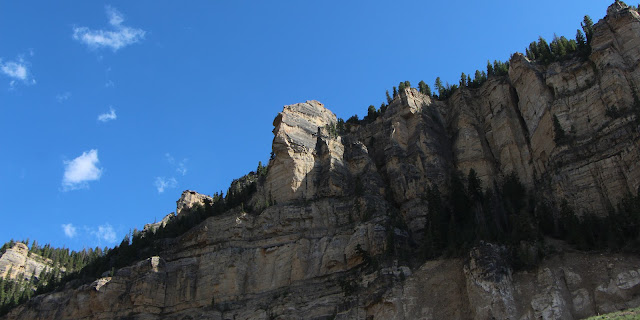 |
| Pipe Spring celebrates some Utah history |
This was a new one for me.
Rich with Native American, early explorer and Mormon pioneer history, Pipe Spring was listed on the National Register of Historic Places in October 1966 and its boundaries were expanded in October 2000.
 |
| A nearby cliff |
The site of a natural spring, the area could sustain life in a harsh desert and, thus, became a destination for all peoples and animals passing through.
 |
| Many travelers came by Conestoga wagon |
 |
| Paiute Tribe; Photo: NPS |
In the 1860s, Mormon pioneers from St. George, Utah, brought in cattle and established a large ranch.
In 1866, local Apache, Navajo and Paiute tribes joined the Utes for the Black Hawk War and, after they raided Pipe Spring, a protective fort was constructed by 1872 over the main spring.
It then continued via pipe to an open tank, creating a cool oasis.
 |
| The namesake spring |
The following year the fort and ranch were purchased by Brigham Young and the LDS bishop of nearby Grafton, Utah, Anson Perry Winsor, was hired to operate the ranch and maintain the fort, soon called Winsor Castle.
 |
| Winsor "castle" |
The Winsors lived there for many years, raising 16 children in the relatively small (but very lovely) house/fort.
 |
| The tour takes you inside |
It served as a waystation for people traveling across the Arizona Strip, the part of Arizona separated from the rest of the state by the Grand Canyon.
It also served as a refuge for polygamist wives during the 1880s and 1890s and operated as a cheese-making operation.
 |
| A walk out to the canyon edge |
The LDS Church lost ownership of the property through penalties involved in the federal Edmunds-Tucker Act of 1887, which restricted polygamy.
Cattle ranching soon gave out because the grasses so prized by the Paiutes could not sustain the herds and died out. The NPS is now trying to repopulate the area with some of the original vegetation.
 |
| A lazy Longhorn |
The Paiutes continued to live in the area and by 1907, the Kaibab Paiute Indian Reservation was established, surrounding the privately owned Pipe Spring ranch, which the government purchased in 1923.
It has a very nice living history tour and gives a very good look at the isolated (and hot) life in early Arizona.
After touring Pipe Spring, I continued toward the Grand Canyon -- witnessing one of the interesting things heat does in the desert -- a giant dust devil.
Trip Date: June 7-13, 2014


No comments:
Post a Comment